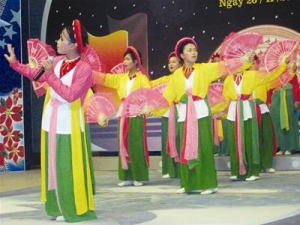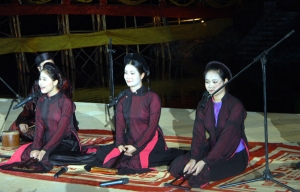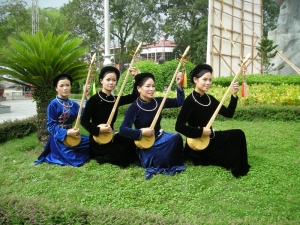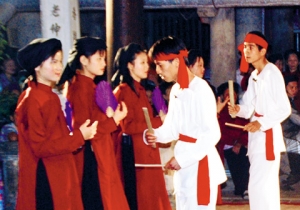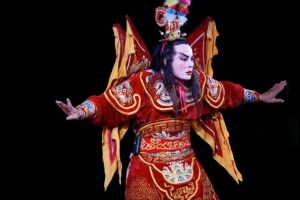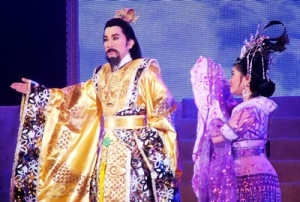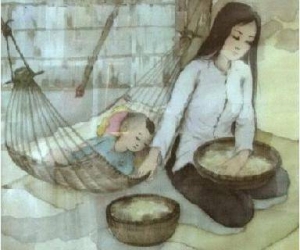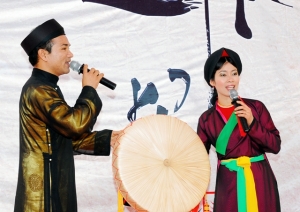
Asia Pacific Travel Team
Cheo Opera
Cheo is a form of popular theatre in Vietnam that has its roots in ancient village festivals.
It consists of folk songs with pantomime, instrumental music and dances, combined with instructive or interpretive sketches dealing with stories from legends, poetry, history or even daily life. Also brought into play are acrobatic scenes and magic. Cheo tells tales of chiefs, heroes and lovely maidens and offers an eclectic mix of romance, tragedy and comedy.
Traditionally Cheo was composed orally by anonymous authors. Today's playwrights compose cheo operas along traditional lines : the characters in the plays sing time-tested popular melodies with words suited to modern circumstances.
The costomes, makeup, gestures and language create typical characters familiar to every member of the audience. The props are simple. As a result, there is a close interchange between the performers and the spectators.
A Cheo play could be put on stage in a large theater, but it could also be performed successfully on one or two bed mats spread in the middle of a communal house with a cast of only three: a hero, a heroine and a clown.
The sound of the Cheo drum has a magical power and upon hearing it, villagers cannot resist coming to see the play. The clown in a cheo play seems to be a supporting role, but actually he or she is very important to the performance. The clowns present a comic portrayal of social life, with ridiculous, satirical words and gestures, they reduce the audience to tears of laughter.
The national Cheo repertoire includes among others Truong Vien, Kim Nhan, Luu Binh - Duong Le, and Quan Am Thi Kinh, which are considered treasures of the traditional stage.
Cheo opera is an integral part of Vietnamese theater and is well-enjoyed by people in both country and town, and by foreign spectators as well. It is particularly relished by foreign tourists in Vietnam tourism and overseas Vietnamese on a tour to Vietnam - their country of origin.
Chau Van singing
Chau van (or frequently called trau van) is a religious form of art which combines singing and dancing and used for extolling the merits of beneficent deities or national heroes. Its music and poetry are mingled with a variety of rhythms, pauses, tempos, stresses and pitches.
Listening to Chau Van singing, you may confuse between the two following types:
Hat tho (worship singing) includes the slow chanting which is accompanied by an act of worship. Variations in the music don’t frequently happen and contain little contrast between pitch and stress.
Hat len dong is the cantillation and dancing of psychic to express the will and orders of some supernatural beings. It may contain many variations depending on the number of verses and often coming to a top or bottom of the meditation.
The instrumental music in Chau van plays a very important role either in emphasizing important passages or creating contrastive effects. Normally, the main instruments that you see in one chau van performance are moon-shaped lute (dan nguyet), accompanied by a rhythm from the striking of a piece of wood or bamboo (phach), clappers (xeng), drum (trong) and gong (chieng). Sometimes, the 16-stringed zither (dan tranh), flute (sao), eight-sound band (dan bat am) are also used in the recitation of certain poetry.
The dress worn by Chau Van singers is based on the cult of the “four palaces” – a red robe symbolizing for the “heavenly palace”, a yellow robe – the “underground palace”, a green robe – the “musical palace” and a white robe – the “aquatic palace”. The headgear and the style of the robe are closely related to the supernatural being honored in the act of worship. Over time, this style of costume may vary but rule about the colors has remained unchanged.
The breathing of a Chau Van singer comes from his or her midriff to nasal cavity which works as a resonance box to create an appropriate effect for religious subjects, particularly, in an atmosphere of incense and candles. Yet, the chanting must be clear enough so that all listeners are able to understand!
The lyrics in Chau Van singing were strongly emphasized. The psychic not only has a good voice and knows how to play musical instruments but he also knows how to give compliments at the right time and in the proper situation.
The art of Chau Van singing originated in the Red River Delta and dated back to the 16th century, later spread to the whole country. It has also adopted the essential beauty of folk songs from the uplands and highlands of the North, Center and South.
In the North, a ceremony always begins the invitation to deities to come. The master of the ceremony reads a petition and says some incantations to the underworld. After sending the invitation to the spirits, a person – frequently a woman – who sat on a mat in front of the altar, will become the speaker for the spirits.
However, one significant aspect of Chau Van singing in Central Vietnam is the mass participants, sometimes five persons in the same ceremony. Chau Van singing in Central Vietnam is generally more prosperous than in the North. The rhythm, furthermore, is far more complicated.
If you desire to see how Chau Van singing is prepared, please come to the festival which is annually organized in the Hon Chen Palace near Hue. Due to the location on the bank of Huong River and the outsize number of participants, the celebration is held on the boats. The river is crowded with thousands of boats and people dressed in colorful clothes, dancing to the offering music in an atmosphere which is full of incense and scent of offering fruits and flowers. Chau Van singing, also called hat bong in the South, follows the same pattern of Chau Van singing in the North and Center. Yet, some of the tunes are influenced by the classical music of the South.
Chau Van singing has acquired over centuries both quintessence and folksy characteristics and proven to be a strong attraction to musicologists at home and abroad! Listening to Chau Van singing means further touching to one unique feature of Vietnamese culture!
Hat Then (Then singing)
"Hat Then" or Then singing characterizes the spiritual and social life of Tay and Nung ethnic people.
"Hat then" performances are important ceremonial events, which unite the entire community.
Long Poems consist of several chapters with different content lengths. A show usually involves two or three groups of singers, plus musicians. The epics last for hours and are devided into short and long chapters, which are often repetitive. Anyone planning to sit through a "hat then" ritual had best get comfortable; the longest epic contains 35 chapters and 4,949 lines.
 In the ceremony procession, not only must the artist carry out elabrate religious rituals, but also act as a general actor singing, playing music, dancing, and making gestures to demonstrate the meaning of the sentence he is singing. Sometimes the artist also performs other activities such as chewing cups and other things.
In the ceremony procession, not only must the artist carry out elabrate religious rituals, but also act as a general actor singing, playing music, dancing, and making gestures to demonstrate the meaning of the sentence he is singing. Sometimes the artist also performs other activities such as chewing cups and other things.
Music is the main element that completely penetrates the performance. Sometimes the music is accompanied with song, and at other moments it serves as a background for dance or connecting parts of a song.The main musical instruments in the "Then" performance is the "Tin Tau" (a traditional stringed musical instrument resembling a guitar) and a chain of shaking instruments. Sometimes the band has a bell present.
All people in the Tay Nung community, regardless of ages, sexes, and religions are fond of "Then" songs. Some groups such as the Kinh Mooing in the same region have also been incorporating this kind of art in their spiritual lives.
Xoan singing or Hat Xoan
Xoan singing, which is in a list of 23 cultural heritages that needs urgent protection and preservation under the 2003 Convention for the Safeguarding of Intangible Cultural Heritage, is a folk cultural product of Phu Tho province.
The last point of time that Xoan accompany still sang in communal houses of the villages in spring was in 1945. Fortunately, we still had an opportunity to meet singers and instrumentalist who used to sing in the Xoan accompany in the old days when we conducted to investigate, study on Xoan singing in the late August.
It can be said that Xoan singing is still engraved in the memory of folk artists who up to now canperform it in the communal house whenever having the festival. Previously, the Xoan singing belonged to four villages, An Thai, Thet, Phu Duc and Kim Đai of Hac Tri district, Phu Tho province. After the innovation, An Thai village belongs to Phuong Lau, Viet Tri city, and Thet, Phu Duc and Kim Dai villages belong to Kim Duc, Phù Ninh district, Phu Tho province. According to folk artists, of those four villages, the singing style of Xoan accompany of An Thái village is similar to that of Thet village and Phu Duc village similar to Kim Dai. However, it is the difference of order of repertoire, words and thenumber of dancer, etc, that also creates the own style of each village.
In 1998, together with the establishment of the club of Xoan singing in Kim Duc communes and An Thai village, Phuong Lau commune brought about new vitality for Xoan singing. The generation of elderly folk artists in the old days always tried their best to hand down offspring compositions in the old style of singing in the activity of Club. On the last August 18th, People’s Committee of Kim Duc commune opened a festival of Xoan singing competition to rise up the passion and pride of villagers to the special art of the locality. When we coming, villagers of each Xoan village were actively practicing and perfecting compositions to be able to found Xoan accompany of each village according to the policy of the Department of Culture and Information of Phu Tho province. The concern of authority and enthusiastic contribution of the villagers are good news of art of Xoan singing in today’s life.
Nowadays, most tourists join tours in Vietnam because they want to learn more about the traditions and cultures of the country in general and each ethnic minority in particular. Therefore, preserving traditional cultural heritages as Xoan singing helps Vietnam promote its image to the world and attract more tourists in Vietnam tourism in the near future.
Tuong (Hat Boi)
Tuong, also called Hat Boi in the south, is a kind of drama of the national theatre. Tuong came into being over five hundred years ago, reflecting the rich and special culture of Vietnam.
The acting seen in this theatre is a dramatic art form in which the actors make use of their technical mastery to describe the actions and states of mind of the characters. This type of acting is different from other styles which require the actors to give up their individuality to transform themselves into the characters of the play.
Tuong stage has a very concise symbolization. Only with some actors on the stage, the whole scene of the court with all the officials who are attending royal ceremonies could be seen, or two generals with some soldiers fighting also show a battle with hundreds of thousands of troops and horses fighting fiercely, and even a gourd of wine and four wooden cups also express a lowish banquet. It is a mistake to deal with Tuong without mentioning the art of making up. It is because just looking at a made-up face; we may guess the personality and social class of that character. For example, a canthsus drawn toward one's ears show that he is a great gentleman and hero. As for beards, a black, curly beard is for a fierce man, three-tuft beard for a gentleman; a dragon's beard for Kings and mandarins and for majesty; a mouse's whisker, a goat's beard and a fox's whisker for cunning and dishonest men. Beardless man must be students.
The gestures of characters on the stage are stylized with symbolization, which attract the viewers passionately. To a western-style drama, when a general rides a horse, it must be a real one or a horse-like costume; but, to an actor of Tuong, only a white, brown red or black whip also means many kinds of horses: black, sorrel or white. The actor of Tuong acts very concisely. Only with a whip, he is able to make the viewers passionate through delicate acting's with horses galloping or at full gallop, of which there are good-mannered or restive ones... With an oar, the actor of Tuong is able to show the viewers the boat fast sailing, wavering due to waves, making the viewers feel as through they were onthe boat.

The accompanying tomtoms in Tuong are very important, because they start the actor's sentiment; they bring the past time and space to the present; they unite the character's sentiment with the stage, and the actor with the audience. The art of Tuong in Vietnam includes those of painting, sculpture through the ways of making up, costumes and dance, pantomine, singing, saying through the actings of actors; as well as the combination of traditional musical instruments of Vietnam. The art of Tuong has raised the lofty view of desire to the true - the good - the beautiful (Chan - Thien - My) as well as the viewpoints of life of the ancients: Benevolence - Righteousness - Civility - Knowledge - Loyalty ( Nhan - Le - Nghia - Tri - Tin) through special characters who are benevolent and righteous. Tuong is one of the valuable pearls reflecting the rich and special culture of Vietnamese people.
Cai Luong or Renovated Opera
In comparison with cheo (popular opera) and tuong (classical opera), cai luong is a new type of theatre in Vietnam, combining drama, modeled after French comedy, and singing.
Cai Luong (Renovated Opera) appeared in the southern part of Vietnam in the 1920s. Now, this form of music is a new type of theatre.
Scenes are elaborate and are changed frequently throughout the play. Cai luong is similar to the Western operettas and more easily depicts the inner feelings of the characters. Songs of the Cai luong are based on variations of a limited number, perhaps 20, of tunes with different tempos for particular emotions - thisconvention permits a composer to choose among 20 variations to express anger, and as many to portray joy.
The principal supporting songs in Cai Luong is the Vong Co (literally, nostalgia for the past). Cai luong owes much of its success to the sweet voices of the cast, much appreciated by the audience. Upon hearing the first bars of the well-loved Vong Co, the audience reacts with gasps of recognition and applause.

The Cai luong performance includes dances, songs, and music; the music originally drew its influences from southern folk music. Since then, the music of Cai luong has been enriched with hundreds of new tunes. A Cai luong orchestra consists mainly of guitarswith concave frets, and danakim.
Over the years, Cai luong has experienced a number of changes to become a type of stage performance highly appreciated by the Vietnamese people as well as foreign visitors in Vietnam tourism.
Lullabies - The deep impression in the heart of Vietnamese people
When we were babies, our mom and our grandmom used to sing the Vietnamese lullabies for us. It was just not to lull us to sleep but also was the way they connected to our heart. At that time, we could not understand the meaning of the lullabies but we could feel the warmth and sweetness of our mom and our grandmom. And we grew up with these lullabies…
Lullaby songs are a sort of folk music often heard in Vietnam, especially in the countryside. They are used not only to lull small children to go to sleep but also to express human feelings such as homesickness, wife missing her husband...
Vietnamese lullabies often consist of two or four six-to-eight meter lines. They are usually based upon a characteristic frame of melody, and use slow, free rhythms. They also contain many inseted words such as "à ơi", "ầu ơ", "ơ", "hỡi"...
As the function of a lullaby song is to make the child slowly fall into sleep, the song is quiet, the tones stretched and melodious.
The melody of lullabies vary from regions to regions.
In North Vietnam, lullabies are sung in five notes, do-re-fa-sol-la. For example,
“My child, sleep well,
So mom can carry water to wash the elephant’s back,
If anyone wants to see, go up to the mountain
To see Lady Trung, Trieu riding the elephant’s golden backs”
The song from central Vietnam lies only in three notes, la-re-fa, with nonsense syllables "ơ" inserted:
“Baby, sleep well,
So mother can go to the market to buy an earthen saucepan,
If she goes to the southern market,
She will buy you a long and bent sugar cane”
In Southern Vietnam, most of the lullabies begin with the word "ví dầu" (imagine
“Imagine you’re walking on a board-bridge fastened with nails,
It is hard as walking on an unstable bamboo bridge”
Although the habit of lulling children in Vietnam nowadays is gradually less popular than in the old days, these lullabies never disappear but become a holy part in every Vietnamese soul who was brought up by maternal love and sweet songs.
Joint Vietnamese-RoK concert held in Bac Ninh
Vietnamese musicians along with their counterparts from the Republic of Korea (RoK) got together to put on a concert on May 9 in the northern province of Bac Ninh to mark the 20th anniversary of the establishment of diplomatic ties between the two countries.
The event was jointly organised by the Association of People loving Vietnam in the RoK and its people (VESAMO), the Association of People loving the RoK in Vietnam and the provincial People’s Committee.
During the concert, many pieces of well known classical music by renowned composers were performed by the Busan orchestra along with Bac Ninh love duet songs (quan ho) by local artists.
Also on the day, the Chairman of the provincial People’s Committee Nguyen Nhan Chien met with a delegation from VESAMO.
He talked briefly about the province’s socio-economic development situation and its policies to attract investment as well as how RoK businesses in Vietnam are performing.
Chien said he hopes that VESAMO will continue to promote cooperation between Vietnam and the RoK in general and between the province and social organisations, and businesses from the RoK and the RoK’s province of Busan in particular.
The President of VESAMO Park Kwang Joo, promised to continue promoting exchanges between the two countries and the two provinces.
VESAMO was first established in 2003 in Busan as an association for individuals and enterprises from the RoK who appreciate the Vietnamese people and their culture. Its main activities include supporting Vietnamese students, guest workers and Vietnamese brides in Busan. The organisation also holds regular meetings and exchanges with Vietnam.


